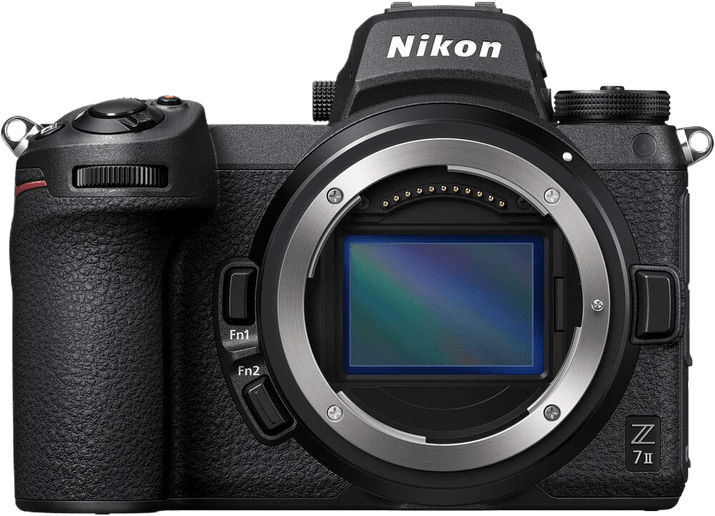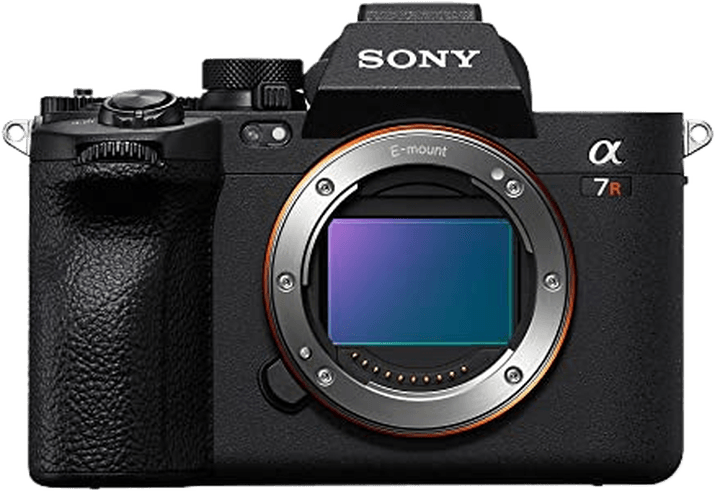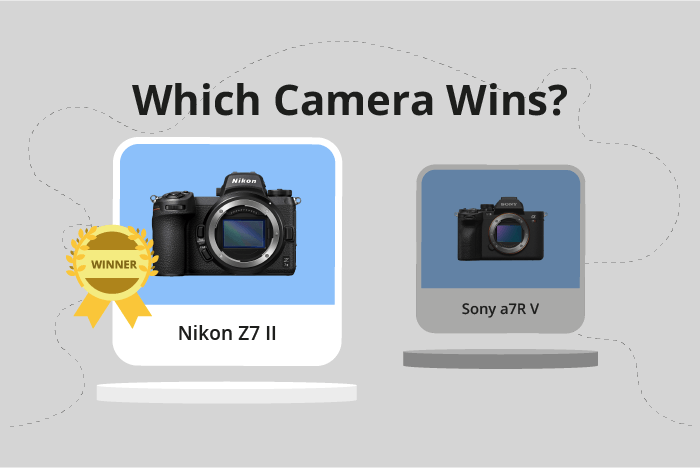Nikon Z7 II vs Sony a7R V Comparison
Nikon Z7 II

Sony a7R V

The Nikon Z7 II and Sony a7R V both score 85/100, showcasing their quality as mirrorless cameras. Despite this, each camera offers unique advantages. They share the same release year and camera type, but the Nikon Z7 II was announced in October 2020, while the Sony a7R V was announced in October 2022.
The Nikon Z7 II is lighter and more compact, weighing 705g and measuring 134 x 101 x 70mm. This camera also has a lower launch price of $3399, making it more affordable. On the other hand, the Sony a7R V weighs 723g and has dimensions of 131 x 97 x 82mm. Its launch price is $3999, making it a more expensive option.
When choosing between these cameras, the Nikon Z7 II offers a more budget-friendly and lightweight option, while the Sony a7R V is a newer model with a higher price tag. Both cameras provide excellent performance with their equal scores.
Nikon Z7 II vs Sony a7R V Overview and Optics
The Nikon Z7 II edges out the Sony a7R V in optics, with a score of 86/100 compared to Sony’s 85/100. Both cameras share many specifications, such as a 10 fps shooting speed, CMOS sensor, full-frame sensor size, and built-in image stabilization. They also have compatible lens mounts, with the Nikon Z7 II using the Nikon Z mount and the Sony a7R V using the Sony FE mount.
The Nikon Z7 II surpasses the Sony a7R V with its higher DXOMARK sensor score of 100, compared to Sony’s 94. This difference indicates that the Nikon Z7 II has a superior sensor, which contributes to better image quality. Furthermore, the Nikon Z7 II is equipped with a dual Expeed 6 processor, which ensures faster processing and better overall performance.
On the other hand, the Sony a7R V boasts a higher megapixel count of 61, compared to the Nikon Z7 II’s 45.75. This advantage allows the Sony a7R V to capture more detail and produce larger prints. Additionally, the Sony a7R V utilizes a Bionz XR processor, which provides efficient processing and noise reduction capabilities.
Considering the optics, the Nikon Z7 II’s higher DXOMARK sensor score and dual Expeed 6 processor make it a better choice for those seeking superior image quality and performance. However, the Sony a7R V’s higher megapixel count and efficient Bionz XR processor make it a strong contender for photographers who prioritize detail and large print capabilities.
Nikon Z7 II vs Sony a7R V Video Performance
The Sony a7R V outperforms the Nikon Z7 II in video capabilities, scoring 100/100 compared to the Nikon’s 91/100. Both cameras share some common specifications, including a maximum video frame rate of 120fps and built-in time-lapse functionality. However, the Sony a7R V has superior features that contribute to its higher score.
The main advantage of the Sony a7R V is its 8K maximum video resolution, which is double the 4K resolution offered by the Nikon Z7 II. The Sony’s maximum video dimensions are also significantly larger at 7680 x 4320, compared to the Nikon’s 3840 x 2160. This higher resolution and larger dimensions provide greater detail and flexibility for videographers, allowing for more creative possibilities in post-production.
The Nikon Z7 II, while not as advanced in video capabilities as the Sony a7R V, still offers a solid performance in this area. Its 4K resolution and 3840 x 2160 video dimensions are suitable for most professional applications, and its 120fps frame rate and built-in time-lapse functionality match those of the Sony a7R V. These features still make the Nikon Z7 II a viable option for videographers who may not require the higher resolution provided by the Sony a7R V.
Comparing the video capabilities of the Nikon Z7 II and the Sony a7R V, it is clear that the Sony a7R V offers superior performance with its 8K resolution and larger video dimensions. This makes it the better choice for videographers seeking the highest quality and creative flexibility. However, the Nikon Z7 II remains a strong contender for those who do not require the additional resolution and can still deliver professional results with its 4K capabilities.
Nikon Z7 II vs Sony a7R V Features and Benefits
The Nikon Z7 II and Sony a7R V both have identical feature scores of 87/100. They share several common specifications, making them comparable in terms of features. Both cameras have a 3.2-inch touchscreen with a screen resolution of 2,100,000 dots. Additionally, they both have flip screens, GPS, WIFI, and Bluetooth capabilities.
Despite the identical scores, the Nikon Z7 II boasts some advantages over the Sony a7R V. The Nikon Z7 II’s strengths lie in its ergonomic design, making it more comfortable to hold and operate for extended periods. Furthermore, the Nikon Z7 II has a more extensive lens selection, providing users with greater flexibility in their photography.
On the other hand, the Sony a7R V does have some advantages over the Nikon Z7 II. The Sony a7R V excels in its autofocus system, which is faster and more accurate than the Nikon Z7 II. This feature is beneficial for photographers who shoot fast-moving subjects or require precise focus.
In comparing the Nikon Z7 II and Sony a7R V, it is evident that both cameras have their strengths and weaknesses. The Nikon Z7 II is better suited for photographers who prioritize ergonomics and lens selection, while the Sony a7R V is ideal for those who need a superior autofocus system. Ultimately, the choice between these two cameras will depend on the specific needs and preferences of the photographer.
Nikon Z7 II vs Sony a7R V Storage and Battery
The Sony a7R V edges out the Nikon Z7 II in storage and battery, scoring 73/100 compared to the Nikon’s 71/100. Both cameras share similarities, including two memory card slots and USB charging capabilities. The Sony a7R V, however, boasts a better battery life of 530 shots, using the NP-FZ100 battery, while the Nikon Z7 II offers 420 shots with its EN-EL15c battery.
In terms of storage, the Nikon Z7 II accepts SD, CFexpress Type B / XQD (UHS-II compatible) cards, whereas the Sony a7R V uses SD / SDHC / SDXC and CFexpress Type A cards. The Nikon’s compatibility with CFexpress Type B / XQD cards gives it an advantage in terms of faster read and write speeds.
Despite the Nikon Z7 II’s slight edge in storage compatibility, the Sony a7R V’s superior battery life makes it a more reliable choice for extended shooting sessions. Therefore, the Sony a7R V is the better option for photographers prioritizing storage and battery performance.
Alternatives to the Nikon Z7 II and Sony a7R V
Are you still undecided about which camera is right for you? Have a look at these popular comparisons that feature the Nikon Z7 II or the Sony a7R V:

